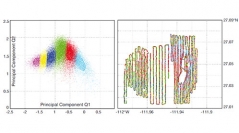

 Geodiversitas
34 (1) - Pages 99-113
Geodiversitas
34 (1) - Pages 99-113Rhodolith-dominated carbonate environments, characterized by high abundances of free-living coralline algae, have been described globally from a wide range of Recent and fossil shallow marine settings. In the present-day warm-temperate Gulf of California, Mexico, rhodolith-dominated systems are important contributors to carbonate production. One of the most prolific rhodolith factories is located on the Punta Chivato shelf, in the central Gulf of California, where due to a lack of input of terrigenous material from the arid hinterland, carbonate content averages 79%. Punta Chivato rhodoliths thrive above the shallow euphotic zone under normal saline, warm-temperate and meso- to eutrophic conditions. A detailed sedimentologic study combined with acoustic seafloor mapping indicates the presence of extensive rhodolith-dominated facies at subtidal water depth covering an area of >17 km2. Additional facies, surrounding the rhodolith-dominated facies include a fine-grained molluscan, a transitional bivalve-rhodolith and a bivalve facies. While the Punta Chivato shelf yields average abundances of 38% rhodolith-derived coralline algal components in the gravel-sized sediment fraction, the rhodolith facies itself is characterized by more than 60% coralline algal components. Other important carbonate producers at Punta Chivato include bivalves (35%), bryozoa (11%) and gastropods (8%). The present study shows that acoustic sediment mapping yields highly resolved continuous coverage of the seafloor and can distinguish modern rhodolith facies from surrounding sediment. This has important implications for quantifying rhodolith-dominated settings globally, as well as for ecological and conservation studies.
Gulf of California, coralline algae, acoustic mapping, rhodalgal